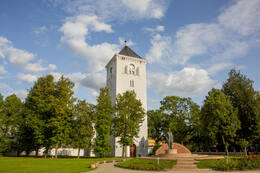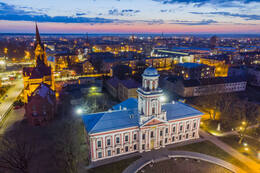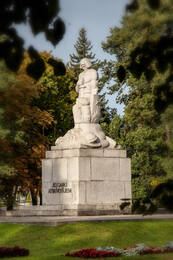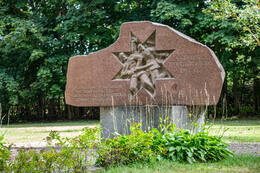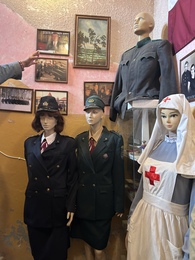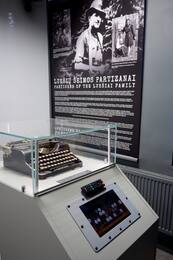The Great Cross-Border Route – Military Heritage of Latvia and Lithuania in 100 Years
Day 1.
90 km
Jelgava - Eleja - Joniški - Šiauliai
Practical info
- The itinerary is intended as a guide - how to optimally travel a region or country, or two countries, with the aim of getting to know their military heritage;
- The driver must plan for himself - how many of the recommended objects and places he can explore in one day;
- Before traveling, you should check the opening hours of sightseeing places (museums, collections, fortifications, etc.);
- In places where advance registration is required (local guides, private collections, other), a visit must be booked, specifying the date and time. If the trip is canceled, the registered places must be informed;
- Accommodation must be booked in advance. Accommodation may be unavailable during the summer season, especially on the coast. Some catering establishments may not be open during the winter season;
- Choose not only summer for your trip, but also other seasons;
- The Latvian-Lithuanian-Estonian borders can be crossed by road freely without restrictions and at any time of the day. When entering from one country to another, you must have an ID card or passport with you;
- Visit tourist information centers where you can get additional information, brochures, and maps.
Sights
The Tower of Jelgava Holy Trinity Church
The Tower of Jelgava Holy Trinity Church is located in the centre of the city of Jelgava.
The history of the tower spans more than four centuries, becoming an important witness to the development of the city, as well as tragic events. The church was built in 1574 on the orders of the Duke of Courland and Semigallia, Gotthard Kettler, and its tower, completed in 1688 under the lead of the construction master Martin Knoch, became one of the most prominent structures of the city.
During the Second World War, Jelgava was severely destroyed and, in 1944, the church burnt down after a Soviet air raid. After the war, the Soviet authorities blew up the altar part of the church and demolished the walls. Only the tower was preserved as a strategic object, as it was the highest point in the city. During and after the war, the tower was used for military purposes. Enemy positions were observed and the surroundings were controlled from the tower.
During the post-war years, the tower also served as a strategic point for resistance activities. It became a secret meeting place and a base for the transfer of information that was essential for the fight against the Soviet regime. The tower, while retaining its historical significance, has been reborn today as a cultural and educational centre.
Jelgava History and Art Museum of Ģ. Eliass
Jelgava History and Art Museum of Ģ. Eliass is located in a building that is called Academia Petrina (Peter’s Academy). It was built in 1775 as the first university in Latvia and is one of the few public buildings in Jelgava to survive and be restored after World War II. In the summer of 1944, Jelgava lost almost everything – a large part of its population and historic buildings, which were hardly restored after World War II. The predecessor of the current museum – the Kurzeme Provincial Museum – was founded in 1818. It was the second oldest museum in Latvia and the first one established outside Riga. The museum has been housed in the Academia Petrina building since 1952. Today, the museum features permanent exhibitions on the renowned Latvian artist Ģederts Eliass (1887–1975), the prehistory and Middle Ages of the Zemgale region, Jelgava during the era of the Duchy of Courland and Semigallia (1561–1795), the Courland Governorate (1795–1918), and the period of Latvia’s independence (1918–1940).
The museum exhibition “Life Continues Under Foreign Rule” explores life in Latvia during the German and Soviet occupations. The virtual exhibition “Wars and a Soldier Through the Ages of Jelgava” offers insight into the various wars that have affected Jelgava, including historical events from the First and Second World Wars.
Monument to the Liberators of Jelgava “Lāčplēsis”
The Monument to the Liberators of Jelgava “Lāčplēsis” is located in Jelgava, at Station Park, opposite the Railway Station building. It was opened on 22 June 1932, with the participation of the President of Latvia A. Kviesis, and was built to commemorate the liberation of Jelgava on 21 November 1919, during the Latvian War of Independence.
In 1940, during the first period of Soviet occupation, the monument was not affected by changes. In 1941, when the Soviet occupiers were replaced by the German occupation forces, the head of the German occupation administration, von Medem, who had returned to Jelgava (his ancestors were the original builders of Jelgava Palace), did not like the unequivocal symbolism of the monument. On 31 October 1942, the German occupation authorities ordered the author of the monument, Kārlis Jansons, to remove the image of a German knight from the monument.
In 1950, the Soviet occupation authorities gave the order for the monument to be destroyed. With the help of a tractor, Lāčplēsis was torn off its pedestal, smashed, and an attempt was made to destroy it in a stone crusher. However, Lāčplēsis proved to be so hard that the crusher broke. The unbroken middle part of the monument was secretly buried in the grounds of a kindergarten.
In 1988, a fragment of the monument was found and is now located in front of the Jelgava History and Art Museum of Ģederts Eliass. The monument was restored and inaugurated on 21 November 1992. It was created by sculptor Andrejs Jansons, who restored the monument created by his father, K. Jansons.
Monument to the Defenders of Jelgava
The Monument to the Defenders of Jelgava – the Daugavgrīva Home Guards who stopped the German Army from attacking Jelgava at the end of April 1915, was unveiled in 1991 next to Svēte School in Jelgava Municipality. At the beginning of May 1915, a large demonstration was held in Jelgava to commemorate this important event. The fact that the Latvian Home Guards managed to stop the German attack was used by Jānis Čakste and his as sociates to justify the idea of establishing Latvian Riflemen units during World War I.
The author of the monument is sculptor Alvīne Veinbaha (1923–2011)
War Museum in Eleja
The museum is located in the former railway station building of Eleja Village.
The War Museum in Eleja was established by the association “Zemgales strēlnieks” (Zemgale Rifleman). The representatives of the association are active in public education, putting on exhibitions, displays and educational programmes.
The exhibition of the museum is mainly dedicated to World War II. It displays uniforms, equipment, armaments, and photographs of the historical period. The museum offers the opportunity to take photos in military uniforms of different historical periods and armies. The small two-storey building houses several hundreds of exhibits of military heritage. In addition, there are exhibits related to the town and surroundings of Eleja, the history of the region and its notable persons.
Joniškis History and Culture Museum
Joniškis Museum of History and Culture was established in the centre of Joniškis in 1989. It features exhibitions reflecting the historical and archaeological treasures, ethnic culture and sacred art heritage of the region. Based on the initiative of historian Darius Vičas. The museum has an exhibition dedicated to the partisans of the Joniškis region. In a separate room, you are introduced to the personalities of partisans – fighters for Lithuanian freedom – and their struggle against the Soviet occupation. The exhibition features an authentic Olympia typewriter that served the last partisans of the Joniškis region, Kostas LiuberskisŽvainys and Steponas Erstikis-Patašonas. It was used to print issues of the partisan periodical “Partizanų šūvių aidas” (Echo of Partisan Shots). The underground newspaper was published from 1952 to 1957 in the territory of the Juozapavičius homeland (on the outskirts of Akmene, Joniškis, Žagarė and Kuršėnai districts). It is the last periodical published by partisans. The typewriter has been modified for interactive access to information – by pressing its keys, visitors see photos and hear stories about the partisan resistance. The radio receiver in
Places to eat
- in Jelgava, see. visit.jelgava.lv
- Ionisky see. visitjoniskis.lt
- Cafe "Svētes Club", Svētes parish
- Fashion Restaurant, Joniški
- Shoals, see. visitseauliai.lt
Places to stay
- in Jelgava, see. visit.jelgava.lv
- Ionisky see. visitjoniskis.lt
- Hotel “Senliči”, Jaunvirslaukas parish, https://www.celotays.com
- Hotel "Shiaurės Vartai", Joniški
- Shoals, see. visitseauliai.lt




